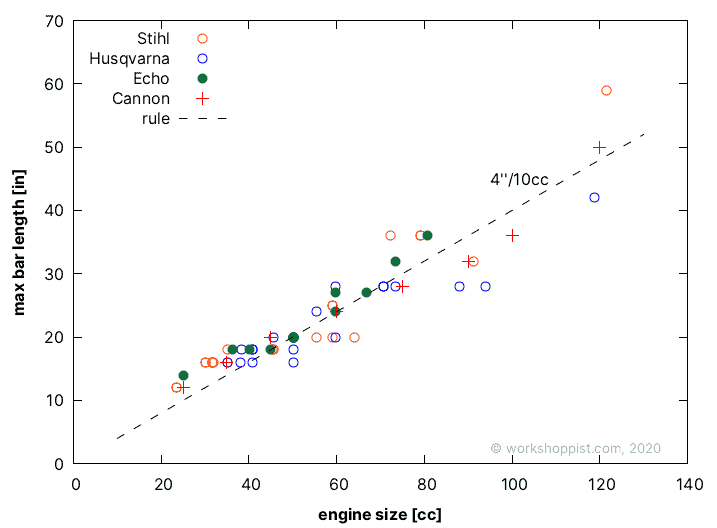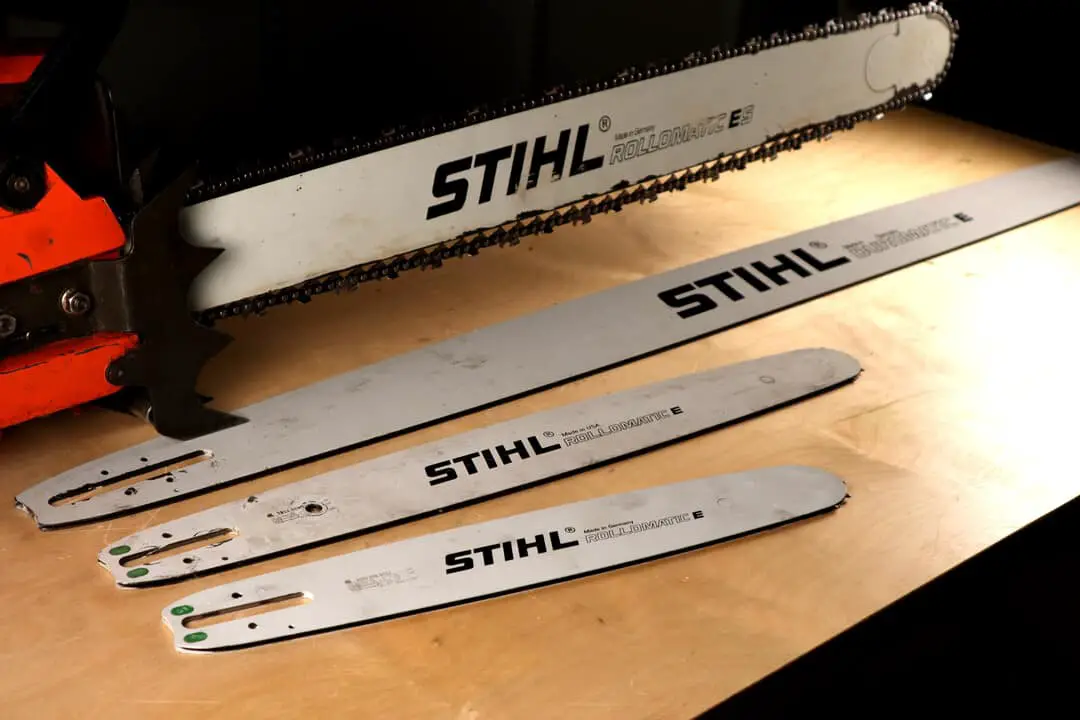Most chainsaws ship with a guide bar that is reasonably sized relative to the saw capacity, but could actually run a longer one. Swapping the original bar for a longer model is often useful, as it may give you just the bit of additional cutting capacity you need in felling or bucking.
But how much longer a bar can you fit on your chainsaw? In this article, I will give a general answer to this question.
A short version of the answer is: The maximum bar length recommended by manufacturers for gasoline-powered chainsaws scales with engine size and averages to around 4” per 10 cc of cylinder displacement. While chainsaws could technically take any length bar with the right mount type and chain pitch, the recommended maximum indicates the upper limit for efficient and safe operation.
We will next go through why bar length is limited, how to find out the maximum bar length, and how I came up with the 4” per 10 cc rule. After reading this article, you have a good idea of the bar length your saw could run. You will also know what kind of powerhead you will need for a certain bar length.
Why is bar length limited?
Chainsaws have a recommended bar length range for a number of legitimate reasons:
1 Limited power: The main reason is that the saw engine has only limited power output, and can run the chain only through a certain cut width. To give an extreme example, putting a 40” bar on a 30 cc saw would make little sense, as the engine would not have the power to run the chain through a cut anywhere nearly this wide.
2 Bar mount: There are also a number of other aspects of saw construction that come into play. For example, the bar mount on the saw is usually scaled with intended bar size, and the mounts on small saws are not designed to handle the weight and torque of a very long bar.
3 Handles: Similarly, the saw handles and their spacing is different in small and large saws to allow best possible ergonomics at each weight class. A long bar is OK to handle on a large saw body with big handles, but very cumbersome on a small top-handle model.
4 Oiler output: The chainsaw bar oiler has a certain maximum flowrate, which is enough for the recommended bar lengths, but may be insufficient for longer bars.
How to find out maximum bar length?
1 Manufacturer recommendations
The best way to find out how long a bar should you be mounting on your chainsaw is to check the manufacturer recommendations for your saw model.
This way is really the best as it takes all of the different factors limiting the bar length into account: the saw maker has checked the power output, ease of handling, mount strength, safety and so on. They have probably also done extensive testing to see that the saw really works well at each recommended bar length.
2 Based on engine size
A more generally applicable way of determining the bar length is based on saw engine size; this is what we are going to focus on in this article.
The reasoning behind this approach is simple:
- Power output is the main limiting factor of bar length
- In gasoline-powered saws, power output correlates well with saw engine displacement (which is usually easier to find out).
- Engine displacement can therefore be used to determine the appropriate bar length
The main benefit of the engine size approach is that it is not specific to any saw brand or model, but applicable to all relatively recent gasoline chainsaws. This is also the only way to go if you cannot find a recommended range for your saw.
Note that this approach does rely on a few assumptions: a) saw power scales with cc as typical in modern chainsaws b) the saw design has been reasonable/typical: bar mount, handles etc. are dimensioned well relative to engine size. Fortunately, these assumptions hold in most cases and are not too restrictive.
Bar length vs. Engine size (cc)
Rather than relying on my limited personal experience, I decided base the bar length to engine size connection on what kind of bars reputable chainsaw manufacturers recommend for their chainsaw models.
The data
To find out, I went through the 2021 lineup of three leading chainsaw manufacturers – Stihl, Husqvarna and Echo – and tabulated the engine size and the recommended bar lengths for each of their gasoline chainsaw models. I also checked the guidelines of Cannon, a replacement bar manufacturer, for max bar length vs. cc of a generic chainsaw.

The data is plotted in the image above. While the points do not quite fall onto a single line, you can see that there is a clear linear trend in the recommendations. The scatter and differences between saw brands are also not too big, giving me confidence that a general rule for bar length really makes sense.
The Bar length rule
From the general trend in the data, a handy rule of thumb for max bar length vs. saw engine size can be formed: for gasoline-powered saws, the maximum bar length in inches is 4/10 times the saw engine displacement in cc. This can be expressed mathematically as
max. bar length [in] = 0.4 x engine size [cc]
The rule can also be put into a verbal form that is perhaps easier to remember:
Every 10 cc of saw engine displacement can run 4” of bar length
In metric units, by a happy coincidence the rule is even simpler:
A chainsaw can run 1 cm of bar length per 1 cc of cylinder displacement
In the table below, you can see what kind of maximum bar lengths this 4”/10cc rule produces for common engine sizes.
| Engine size [cc] | Max bar length [in] | [cm] |
|---|---|---|
| 30 cc | 12” | 30 cm |
| 40 cc | 16” | 40 cm |
| 50 cc | 20” | 50 cm |
| 60 cc | 24” | 60 cm |
| 75 cc | 30” | 75 cm |
| 90 cc | 36” | 90 cm |
| 120 cc | 48” | 120 cm |
Using the rule
The rule is intended to give you a rough idea of the bar length each saw size can typically run well. A few points:
- You can use the rule to roughly determine the max bar length for your saw in case you find no info from the saw manufacturer
- It also tells you how large you would need to run a 24” bar for example
- The rule should be applicable to recent gasoline models of all chainsaw manufacturers, but …
- The rule is not a substitute for the manufacturer recommendations
You should still check the manufacturer recommendations, whenever available. The reason is that the general rule can applies well only to typical chainsaws, and cannot cover exceptional saw designs. An another reason is that there is some real variation in ”typical” saws too: between 75 cc and 90 cc, for example, Stihl recommends bars up to 8” longer than Husqvarna.
A note on bar compatibility
Last, note that bar length is not the only consideration you have when selecting a replacement bar for your saw: for any length bar to work on your saw, it has to be compatible with your saw.
What makes a bar compatible? In short, a guide bar is compatible with a certain chainsaw if it has two things: the same bar mount type and the same chain pitch as the saw.
So before rushing to get the first long bar to go with your saw, please make sure it is actually compatible. I have a separate article dedicated to answering this question, and an another focusing on Stihl bar compatibility in particular, which you can check for instructions.
